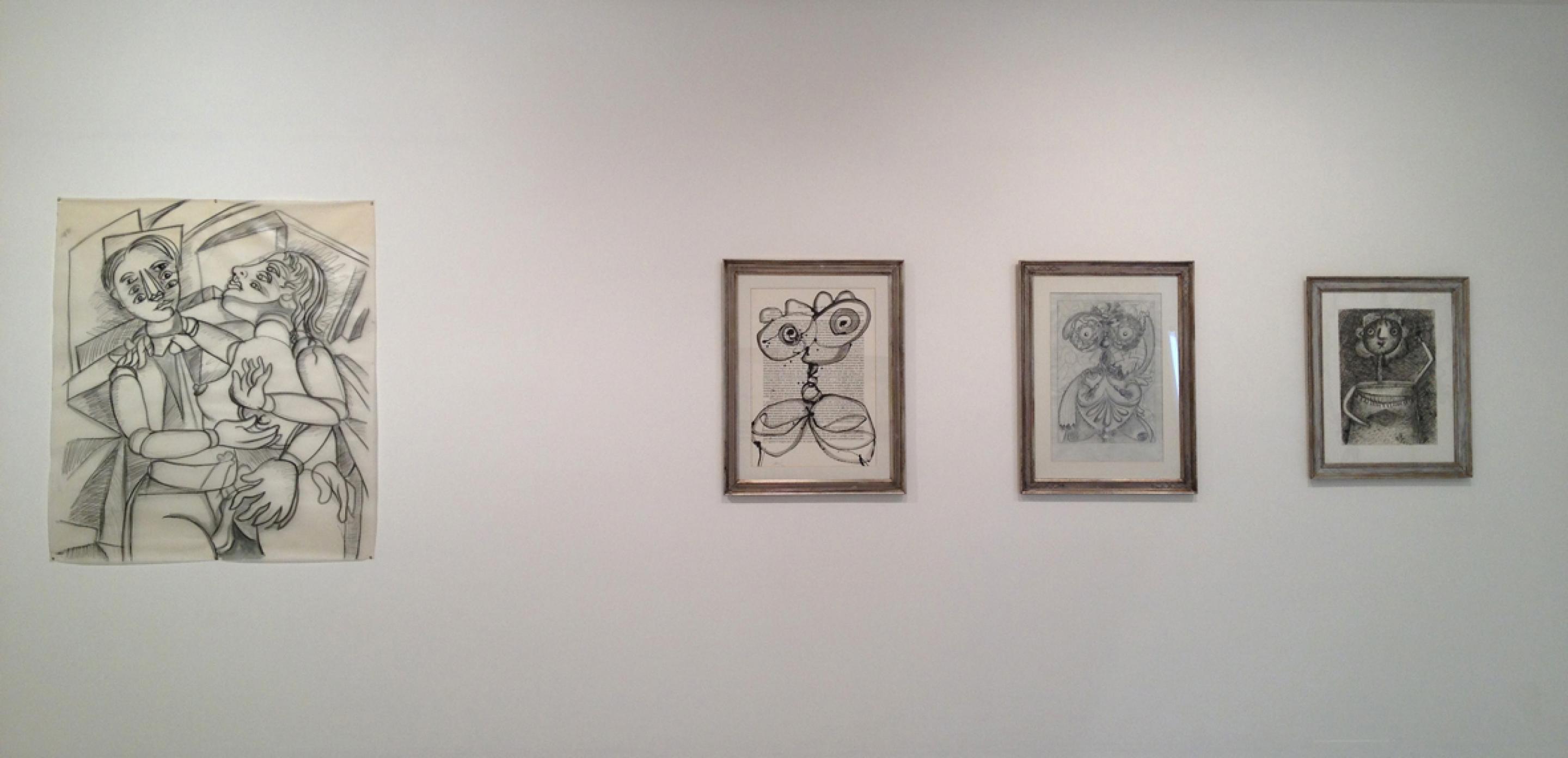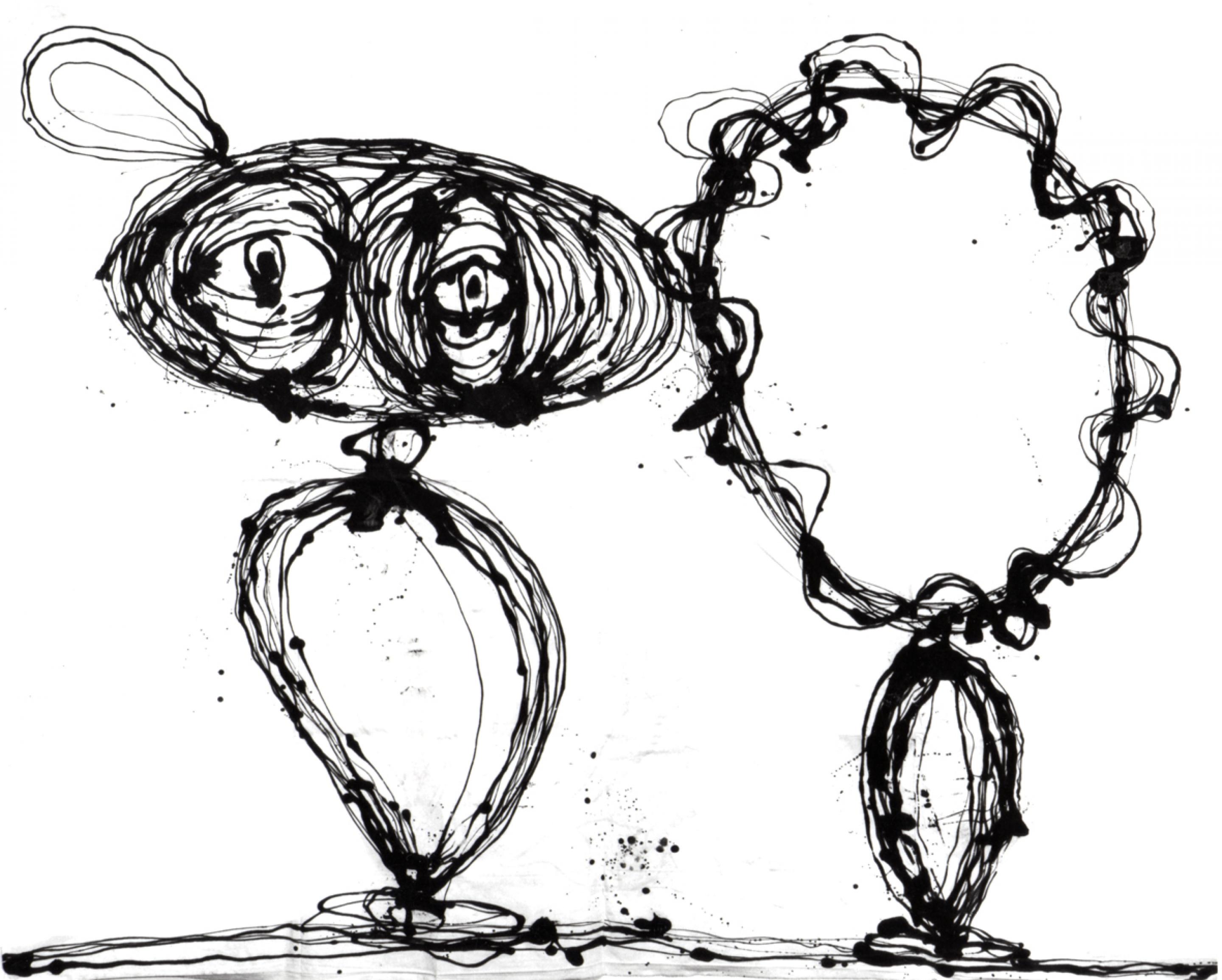EnricoBAJ
Enrico Baj. Segni e disegni
09.2013–10.2013
Enrico Baj. Segni e disegni
09.2013–10.2013
Press Release
Enrico Baj
Segni e disegni
Opening: September 17, 2013
September 18 – October 19, 2013
Segni e disegni
Opening: September 17, 2013
September 18 – October 19, 2013
The Marconi Foundation is pleased to pay homage to Enrico Baj who passed away ten years ago.
His works are presently on display in several prestigious venues: a selection of Ladies is presented at the Venice Biennial, within The Encyclopedic Palace, in a show curated by Cindy Sherman, until November 24; the exhibition Ububaj, displaying the Ubu Roi cavanses, is at the CAMeC Museum in La Spezia till October 6; the exhibition Enrico Baj. Bambini, ultracorpi & altre storie will be dedicated to Enrico Baj as a protagonist of the Fifties and Sixties artistic debate, at the Fondazione Pomodoro from September 24 to December 20.
The departure of Enrico Baj, a protagonist of Italian art of the second half of the Nineteenth century, has left an irreplaceable gap in the contemporary art scene.
A provocative and versatile artist, author of imaginative assemblages, multiples and graphic works, Enrico Baj has always had close relations with Italian and foreign poets and intellectuals, supporting writing to painting.
He has participated in the drafting of various avantgarde magazines and has published numerous books on art and other topics.
His multiform and prolific artistic path has been extensively investigated in all its aspects and periods, all marked by a dissacrating irony and a constant pursuit of renewed forms of expression.
On the one hand, the “mirrors”, the “furniture”, the “meccanoes”, the “generals”, the “ladies”, the “modifications”, the “d'après” make up the fun and playful strand.
On the other hand, nuclear figures from the Fifties put in evidence a strong civic commitment against all forms of aggression that will lead to prominent works like The Funeral of the Anarchist Pinelli (1972), Nixon Parade (1972) and Apocalypse (1979).
Giorgio Marconi became a friend of the Milanese artist in the Sixties and, since then, he has organised several shows focused on Baj’s oeuvre, initially at the Studio Marconi, later at the Marconi Foundation, among which Ladies and Generals (2008), Animated Furniture (2009) and Plastics (2010), just to mention the most recent ones.
On this occasion, the Marconi Foundation intends to pay a tribute to the artist with an exhibition of drawings – part of them unseen to the public – an almost unique “repertoire” different from any other, in order to raise visitors interest on Enrico Baj’s work beyond his “main” artistic output.
His works are presently on display in several prestigious venues: a selection of Ladies is presented at the Venice Biennial, within The Encyclopedic Palace, in a show curated by Cindy Sherman, until November 24; the exhibition Ububaj, displaying the Ubu Roi cavanses, is at the CAMeC Museum in La Spezia till October 6; the exhibition Enrico Baj. Bambini, ultracorpi & altre storie will be dedicated to Enrico Baj as a protagonist of the Fifties and Sixties artistic debate, at the Fondazione Pomodoro from September 24 to December 20.
The departure of Enrico Baj, a protagonist of Italian art of the second half of the Nineteenth century, has left an irreplaceable gap in the contemporary art scene.
A provocative and versatile artist, author of imaginative assemblages, multiples and graphic works, Enrico Baj has always had close relations with Italian and foreign poets and intellectuals, supporting writing to painting.
He has participated in the drafting of various avantgarde magazines and has published numerous books on art and other topics.
His multiform and prolific artistic path has been extensively investigated in all its aspects and periods, all marked by a dissacrating irony and a constant pursuit of renewed forms of expression.
On the one hand, the “mirrors”, the “furniture”, the “meccanoes”, the “generals”, the “ladies”, the “modifications”, the “d'après” make up the fun and playful strand.
On the other hand, nuclear figures from the Fifties put in evidence a strong civic commitment against all forms of aggression that will lead to prominent works like The Funeral of the Anarchist Pinelli (1972), Nixon Parade (1972) and Apocalypse (1979).
Giorgio Marconi became a friend of the Milanese artist in the Sixties and, since then, he has organised several shows focused on Baj’s oeuvre, initially at the Studio Marconi, later at the Marconi Foundation, among which Ladies and Generals (2008), Animated Furniture (2009) and Plastics (2010), just to mention the most recent ones.
On this occasion, the Marconi Foundation intends to pay a tribute to the artist with an exhibition of drawings – part of them unseen to the public – an almost unique “repertoire” different from any other, in order to raise visitors interest on Enrico Baj’s work beyond his “main” artistic output.
A selection of 24 drawings on tracing paper will be on display; some of them are preliminary studies to important works, others are just “notes” in a drawing form that the artist used to quickly sketch on paper to translate his own thoughts into shapes and figures.
Some of these preliminary studies will give birth to important works, featuring stars, squiggles roughly sketched faces, “nuclear” shapes, monstruous personae, multitudes of human heads and bodies.
Together with this selection, the exhibition will include three big-sized canvases: The Baj Family (1980), a very large charcoal drawing on canvas, Study for Apocalypse, (1978) and Ubu (1983) both executed by means of a dripping of black paint on canvas.
Ubu is an evident reference to Baj’s contribution to the world of theatre and to his connection with surrealism, of which Alfred Jarry’s Ubu Roi was a precursor.
For this play, staged by Massimo Schuster in 1984 and performed for over ten years worldwide, Baj had produced about fifty puppets (some of them are exhibited at the CAMeC Museum in La Spezia).
Study for Apocalypse is part of a great cycle of paintings, a work in progress started by the end of the Seventies till 1982.
Furthermore, The Great Attractor, (1990) a combinatoire composed of 27 panels, conceived and designed in a lapse of six months, is one of the numerous works dedicated to the crowd, and is executed with acrylics and charcoal and a collage of mirrors.
Documentary materials and catalogues concerning Enrico Baj’s huge and articulated work will be included in the exhibition, together with some films on the artist’s private and professional life.
The exhibition on Enrico Baj will continue at the Studio Marconi ’65 where his graphic works and drawings will be on display.
Some of these preliminary studies will give birth to important works, featuring stars, squiggles roughly sketched faces, “nuclear” shapes, monstruous personae, multitudes of human heads and bodies.
Together with this selection, the exhibition will include three big-sized canvases: The Baj Family (1980), a very large charcoal drawing on canvas, Study for Apocalypse, (1978) and Ubu (1983) both executed by means of a dripping of black paint on canvas.
Ubu is an evident reference to Baj’s contribution to the world of theatre and to his connection with surrealism, of which Alfred Jarry’s Ubu Roi was a precursor.
For this play, staged by Massimo Schuster in 1984 and performed for over ten years worldwide, Baj had produced about fifty puppets (some of them are exhibited at the CAMeC Museum in La Spezia).
Study for Apocalypse is part of a great cycle of paintings, a work in progress started by the end of the Seventies till 1982.
Furthermore, The Great Attractor, (1990) a combinatoire composed of 27 panels, conceived and designed in a lapse of six months, is one of the numerous works dedicated to the crowd, and is executed with acrylics and charcoal and a collage of mirrors.
Documentary materials and catalogues concerning Enrico Baj’s huge and articulated work will be included in the exhibition, together with some films on the artist’s private and professional life.
The exhibition on Enrico Baj will continue at the Studio Marconi ’65 where his graphic works and drawings will be on display.








